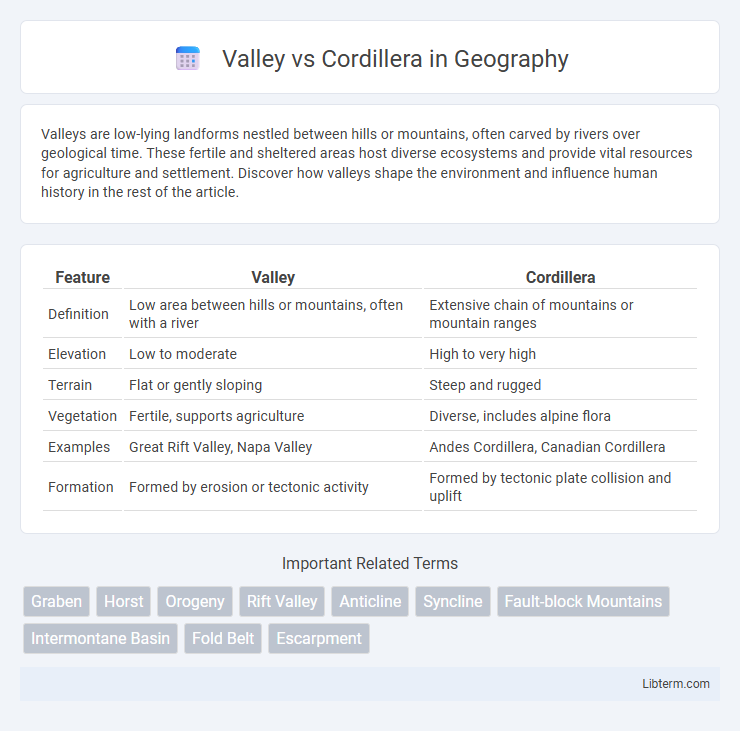Valleys are low-lying landforms nestled between hills or mountains, often carved by rivers over geological time. These fertile and sheltered areas host diverse ecosystems and provide vital resources for agriculture and settlement. Discover how valleys shape the environment and influence human history in the rest of the article.
Table of Comparison
| Feature | Valley | Cordillera |
|---|---|---|
| Definition | Low area between hills or mountains, often with a river | Extensive chain of mountains or mountain ranges |
| Elevation | Low to moderate | High to very high |
| Terrain | Flat or gently sloping | Steep and rugged |
| Vegetation | Fertile, supports agriculture | Diverse, includes alpine flora |
| Examples | Great Rift Valley, Napa Valley | Andes Cordillera, Canadian Cordillera |
| Formation | Formed by erosion or tectonic activity | Formed by tectonic plate collision and uplift |
Introduction to Valleys and Cordilleras
Valleys are elongated low areas typically formed by river erosion or glacial activity, often nestled between hills or mountains and serving as critical zones for agriculture and human settlement. Cordilleras refer to extensive chains of mountains or mountain ranges, characterized by rugged terrain and significant geological activity, extending over large geographic regions such as the Andes or the Rockies. Both landforms significantly influence climate, biodiversity, and hydrology within their regions, shaping natural habitats and human development patterns.
Defining Valleys: Features and Formation
Valleys are elongated low areas often situated between hills or mountains, formed primarily through erosion by rivers or glaciers over millions of years. These landforms exhibit features such as gentle slopes, fertile soil, and a river or stream running through their base, supporting diverse ecosystems and human settlements. Valleys differ from cordilleras, which are extensive, rugged mountain ranges characterized by sharp peaks and significant elevation changes caused by tectonic plate movements.
Understanding Cordilleras: Structure and Origins
Cordilleras are extensive mountain ranges formed primarily by tectonic plate collisions, resulting in complex structures of folded rock layers, fault systems, and volcanic activity. These structurally diverse regions contrast with valleys, which are lower-lying areas often created by erosion or tectonic subsidence between mountain ranges. Understanding cordilleras involves analyzing their geotectonic origins, geological composition, and ongoing seismic processes shaping their rugged topography.
Geographic Distribution of Valleys and Cordilleras
Valleys are typically found between mountain ranges or hills, commonly occurring in regions with extensive river systems that carve out low-lying areas, such as the Great Rift Valley in East Africa or the Central Valley in California. Cordilleras, on the other hand, are extensive chains of mountain ranges that stretch across continents, exemplified by the North American Cordillera spanning from Alaska to Mexico and the Andes in South America. The geographic distribution of valleys is often influenced by erosion and tectonic activity, while cordilleras are primarily formed by the collision and subduction of tectonic plates, resulting in prominent mountainous terrain.
Key Differences Between Valleys and Cordilleras
Valleys are low-lying landforms typically formed by river erosion or glacial activity, characterized by their flat or gently sloping floors and surrounding hills or mountains. Cordilleras refer to extensive mountain ranges, often composed of multiple parallel chains, featuring high elevations, rugged terrain, and significant geological complexity. The key differences lie in their elevation, formation process, and topographical features, with valleys serving as depressions within the landscape while cordilleras represent elevated mountain systems.
Climate and Biodiversity in Valleys vs Cordilleras
Valleys typically experience milder temperatures and higher humidity due to lower elevation and proximity to water bodies, fostering diverse ecosystems with rich plant and animal life. Cordilleras, characterized by higher altitudes, have cooler, drier climates that support specialized alpine flora and fauna adapted to harsh conditions. The distinct climate variations between valleys and cordilleras create unique biodiversity hotspots, with valleys harboring more dense vegetation and cordilleras serving as refuges for endemic species.
Human Settlements and Cultural Impact
Valleys often support dense human settlements due to fertile soil and access to water, fostering agriculture-based communities with rich cultural traditions tied to farming and river ecosystems. In contrast, cordilleras, with their rugged terrain and higher altitudes, tend to have sparser populations, but indigenous groups in these mountainous regions develop distinct languages, rituals, and social structures adapted to the challenging environment. Both landforms significantly shape cultural identities and settlement patterns, influencing architectural styles and resource management practices unique to each geographic setting.
Economic Significance: Agriculture, Tourism, and Resources
Valleys serve as fertile agricultural hubs due to rich alluvial soils and accessible water sources, supporting diverse crop production and livestock farming that fuel local economies. Cordilleras attract tourism with their scenic mountain landscapes, trekking trails, and biodiversity, generating revenue through eco-tourism and adventure sports industries. Both regions hold valuable natural resources; valleys are often centers for mineral extraction and irrigation-based agriculture, while cordilleras contain timber, minerals, and hydropower potential critical for regional development.
Environmental Challenges and Conservation
Valleys often face environmental challenges such as soil erosion, water pollution from agricultural runoff, and habitat fragmentation due to urbanization, necessitating targeted conservation efforts like riparian buffer restoration and sustainable land management. Cordilleras, characterized by mountainous terrain, confront issues including deforestation, landslides, and climate change impacts on biodiversity, prompting conservation strategies focused on forest preservation, slope stabilization, and protected area designation. Both landforms require adaptive management that integrates local ecological conditions to maintain ecosystem services and biodiversity resilience.
Conclusion: Comparing Valleys and Cordilleras
Valleys are low-lying landforms often formed by river erosion or glacial activity, providing fertile soil and habitats for diverse ecosystems. Cordilleras, on the other hand, are extensive mountain ranges characterized by rugged terrain, significant elevation, and geological complexity. While valleys support agricultural development and human settlement, cordilleras play a crucial role in climate regulation, biodiversity conservation, and natural resource availability.
Valley Infographic

 libterm.com
libterm.com